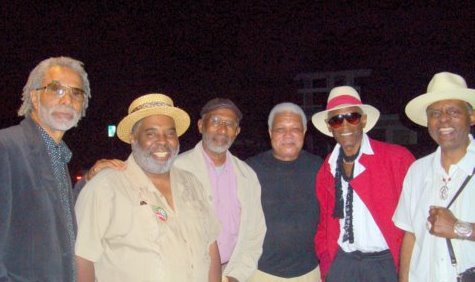Former San Francisco State College/University students and members of the NSA and BSU and community brothers, founders of Black Dialogue Magazine, a critical BAM journal: Aubrey LaBrie, Marvin X, Abdul Sabrey (Gerald LaBrie), Al Young; Arthur Sheridan, founding editor and Duke Williams.
Part One: The Visionary Students ine the Untold Story of the Black Student Revolution at San Francisco State University
--Marvin X
8/6/18
When we have been asked to recall the significance of our Black student revolution on campus and in the community, most of us had no idea what we were doing. Perhaps we were guided by the liberation energy in our DNA. For sure, many of us had no idea we were continuing the liberation struggle of those who came before. In our newfound white supremacy knowledge, we imagined we invented the wheel of Black liberation, after all, we morphed from Negro Students Association to the Black Student Union.
But how did we get from Negro to Black? Imagine, we members of the NSA fought the name change to BSU. I was there and even I may have put up some resistance to the name change, no matter I had just transferred from Oakland's Merritt College where I received a proper dose of Revolutionary Black Nationalism from Donald Warden's Afro-American Association and from peer group study with fellow students Huey P. Newton, Bobby Seale, Ernie Allen, Richard Thorne, Ann Williams, Ken and Carol Freeman, Issac Moore, Maurice Dawson, et al. Peer Group study was our black studies. Then there was Rap sessions on the steps on Merritt College. Rapping meant extemporaneous speaking (free style) on political events, especially the national liberation of African states freeing themselves of colonialism, while we came to understand we were victims of domestic colonialism.
We studied E. Franklin Frazier's Black Bourgeoisie, Frantz Fanon's Wretched of the Earth, the writings of Kwame Nkrumah, Nelson Mandela's writings and the Sharpesville Massacre. On the eve of Kenya's independence, we studied Jomo's Kenyatta's ethnography of his Kikuyu tribe, Facing Mount Kenya. AAA member wore sweatshirts with Kenyatta's picture.
Many of us Merritt students were unofficial followers of Malcolm X, especially after he addressed seven thousand students at UC Berkeley. I listened to him later that night at the NOI Mosque on 7th and Henry in West Oakland. Judy Juanita wrote a story about Black Nationalists at Merritt, featuring Isaac Moore and myself in the student newspaper.
Conscious parties was a most useful ritual in our revolution in consciousness at Merritt. A conscious party is when we gather for a social party but it is pre-planned that at a certain point the music stops, lights come on and we rapped on revolution, then we again played the music and turned down the lights. This was often repeated throughout the evening.
As revolutionary black nationalists, no white people were allowed, no matter than some brothers were with white women. Perhaps we were narrow minded nationalists when we refused to consider the plea from brothers with white women than their woman was black in consciousness, and she probably was, but this notion didn't work as the but erliberation movement morphed from integration to Black Power. When Eldridge and I founded the Black House Political and Cultural Center in San Francisco, 1967, and Mrs. Amina Baraka was there with Amiri who used Black House at their community headquarters (she was also pregnant at this time with their first child, Obalaji, she neveut r lets me forget how my partner and BAM comrade, Ethna X. Wyatt, aka Hurriyah Asar, told a woman at the door who said she was Native American and white, "The Native American can come in but the white got to go!"
Merritt students connected with RAM, the Revolutionary Action Movement, headed by Robert F. Williams, (Negroes With Guns) and Max Stanford to produce SoulBook, the revolutionary black nationalist magazine, featuring the early writings of Grace and James Boggs, Little Willie of South Africa, Askia Toure, Ken and Carol Freeman, LeRoi Jones, aka Amiri Baraka, Sonia Sanchez, Marvin X, et al. Soulbook was a critical publication of the BAM/BLM.
FYI, the Oakland Afro American Association's Los Angeles representative was Maulana Ron Karenga. Did Kwanza originate in Oakland. Ask AAA member Ed Howard.
As per Marvin X (Jackmon) and the West Coast Black Arts Movement, his first writings were published in the Merritt College Student Magazine and later Soulbook Magazine. Creative Writing instructor Adam Miller had the dramatic troupe Aldridge Players West before Black Arts West was founded by Ed Bullins and myself, San Francisco, 1966, Fillmore Street.
In short, the AAA had created a well of Black consciousness in the Bay, not to neglect Oakland was the end of the line for Amtrak, including the West Coast headquarters of the Pullman Porters Union, the first Black union in America, with C.L. Dellums, uncle of recently deceased US Congressman and Mayor of Oakland, Ronald V. Dellums (RIP). Most importantly, Oakland's Seventh Street and San Francisco's Fillmore were the cultural and economic Harlem of the West!




No comments:
Post a Comment